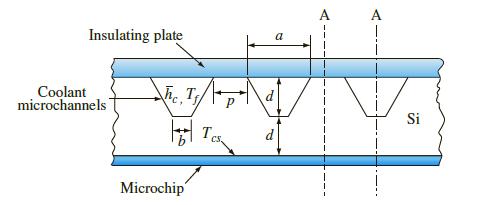A novel method to cool high-powered microelectronic chips and chip modules is to etch the liquid coolant
Question:
A novel method to cool high-powered microelectronic chips and chip modules is to etch the liquid coolant flow channels in silicon (Si) substrate itself [9–12]. A typical such arrangement with channels of trapezoidal cross section is shown in the figure. The channel and silicon substrate dimensions are as follows: α = 481.4 μm, b = 200 μm, d = 200 μm, and p = 250 μm. The thermophysical properties of silicon are p = 2300 kg/m3, c = 750 J/kg K, and k = 3.6 W/m K. The liquid coolant flowing the trapezoidal channels is at T∫ = 20°C with a convection heat transfer coefficient h̅c = 61,250 W/m2 K. If the maximum temperature at the chip interface has to be Tcs ≤ 75°C, determine
(a) The temperature distribution in the silicon substrate due to conduction and the transfer of heat to the coolant in the microchannel
(b) The maximum heat flux dissipation that is accommodated at the chip interface. For the numerical solution and the associated nodal network that needs to be constructed due to symmetry in the geometrical arrangement, consider only the segment indicated by the planes “A–A” in the figure. Also for the heat flux calculation, consider the chip area to be (p + a) × (p + a).
Step by Step Answer:

Principles Of Heat Transfer
ISBN: 9781305387102
8th Edition
Authors: Frank Kreith, Raj M. Manglik, Mark S. Bohn





